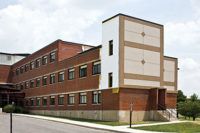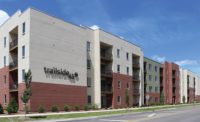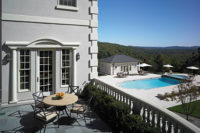Newly-adopted changes in the nation’s building codes to improve energy efficiency are stimulating growth in America’s EIFS industry. These federally-mandated rules now require the use of an Air Barrier and Continuous Insulation outboard of the stud cavity, which has placed renewed focus on improvements in the traditional Exterior Insulated Finish Systems of old.
The air barriers in buildings traditionally comprised different materials and assemblies, but most commonly consisted of building wraps and self-adhesive membranes, two methods that have been used for more than 25 years as protection for the building substrate. Paper wrap often incorporated a self-adhesive membrane at transitions, window or door openings and substrate penetrations. Self-adhesive membranes were sometimes installed over the entire substrate including transitions, window and door openings and substrate penetrations.
Innovation came in the form of fluid-applied moisture barriers, which were initially designed to function as substrate protection and as a component of a drainage EIF system. As the demand increased for constructing a more energy efficient building envelope, air and moisture barriers became products that could be used to protect the substrate regardless of the type of cladding on the exterior.
Today, the most popular choice for an air/moisture barrier behind an EIF system is one that is fluid applied. In addition to securing the building envelope, the fluid-applied air and moisture barrier also provides cost-saving efficiencies at the job site. Indeed, some may be left exposed to the elements for anywhere from one to six months depending on the exterior cladding.
Why Fluid Applied Air and Moisture Barriers Have Been Widely Adopted
- They simplify the specification and design process. This is because they do quadruple duty–providing protection against moisture intrusion, water leakage, mold and mildew.
- They are NFPA 285 compliant when tested by the manufacturer, meaning they can be used on both combustible (Type V) and noncombustible construction (Types I-IV).
- They are easy to install and do not require highly skilled labor. Result? Reduced risk of installation errors that could compromise in-service performance.
- They can be either permeable to water vapor, thus minimizing the risk of condensation caused by the drying process, or vapor impermeable depending on design requirements.
- They are structurally sound, remaining rigid and stable under air and wind pressure loads.
- They resist air leakage and thus increase occupant comfort, cut energy costs and reduce the risk of condensation caused by air leaks.
Adoption of the new energy codes has also impacted another component of the EIFS assembly– the insulation itself. That’s because the most energy efficient and cost effective method to meet all of the mandated energy requirements is to attach insulation on the outboard side of the stud cavity. In fact industry studies have shown the value of continuous insulation installed outboard of the sheathing is 99 percent effective, compared to 60 percent or less for batt insulation installed in the stud cavity. This exterior insulation option is one that many architects and designers now choose when designing new buildings, and the demand has led to the development of new EIF systems that utilize extruded polystyrene for the continuous insulation.
Why Next-generation EIFS Innovation Has Wide Appeal
- It is a highly energy-efficient system that yields significant savings in cooling and heating costs.
- It is an extremely durable system that extends the life-cycle of a given building.
- It provides exceptional resiliency with a compressive strength of 20 psi.
- It meets NFPA 285 fire testing acceptance criteria for wall assemblies.
- It is a sustainable system with a smaller carbon footprint than most claddings.
- It contains polystyrene that is HCFC-(hydrochlorofluorocarbon) free, with zero ozone-depletion potential and is a recyclable product.
- It offers a unique, patented self-cleaning finish option with self-cleaning properties.
What’s clear is that EIFS have evolved significantly in recent years. The new focus on energy efficiency has rekindled innovation, and the industry leaders have responded with next-generation products that meet the new design requirements and sustainability standards.









Report Abusive Comment